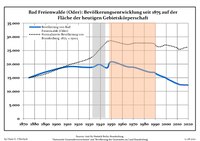Bad Freienwalde
Bad Freienwalde | |
|---|---|
 St Nicolas Church and town hall | |
Location of Bad Freienwalde within Märkisch-Oderland district  | |
| Country | Germany |
| State | Brandenburg |
| District | Märkisch-Oderland |
| Subdivisions | 7 Ortsteile |
| Government | |
| • Mayor | Ralf Lehmann (Ind.) |
| Area | |
• Total | 131.73 km2 (50.86 sq mi) |
| Highest elevation | 158 m (518 ft) |
| Lowest elevation | 10 m (30 ft) |
| Population (2022-12-31)[1] | |
• Total | 12,360 |
| • Density | 94/km2 (240/sq mi) |
| Time zone | UTC+01:00 (CET) |
| • Summer (DST) | UTC+02:00 (CEST) |
| Postal codes | 16259 |
| Dialling codes | 03344 |
| Vehicle registration | MOL, FRW, SEE, SRB |
Bad Freienwalde is a spa town in the Märkisch-Oderland district in Brandenburg, Germany.
Geography
The town is situated on the Alte Oder, an old branch of the Oder River at the northwestern rim of the Oderbruch basin and the steep rise of the Barnim Plateau. It is located 15 km (9.3 mi) east of Eberswalde, and 50 km (31 mi) northeast of Berlin, near the border with Poland.
Bad Freienwalde has an Evangelical and a Roman Catholic church as well as manufactures of furniture and machinery. The neighbouring forests and its medicinal springs make it a favorite summer resort of the inhabitants of Berlin. A new tower commands a fine panoramic view over the Oder valley.
The municipal area comprises the villages of Altranft, Altglietzen, Bralitz, Hohensaaten, Hohenwutzen, Neuenhagen and Schiffmühle.
History

The settlement of Vrienwalde in the Margraviate of Brandenburg was first mentioned in a 1316 deed and appeared as a town in 1364. From 1618, the Freienwalde manor was directly held by the Brandenburg prince-electors (Kurfürsten).
A mineral spring was discovered in 1683. The alchemist Johann Kunckel brought it to the attention of the "Great Elector" Frederick William of Brandenburg, who, gout-ridden, arrived in Freienwalde the next year. Recorded by the physician Bernhardus Albinus in 1685, the Kurfürstenquelle became the foundation of Freienwalde's rise as a spa town. Frederick William's son King Frederick I of Prussia had a first maison de plaisance erected by the architect Andreas Schlüter.
The development was further promoted, when in 1799 the small Neoclassical Freienwalde Castle was built according to plans by David Gilly as a summer residence of Princess Frederika Louisa of Hesse-Darmstadt, the widow of King Frederick William II of Prussia. Its park was redesigned by Peter Joseph Lenné in 1822. The industrialist and politician Walther Rathenau acquired the palace in 1909, it was nationalised after his assassination in 1922. Freienwalde achieved the official status of spa town (Bad) in 1925.
Notable people
- Edith Andreae (1883–1952) sister of Walter Rathenau.
- Alfred Blaschko (1858–1922), dermatologist
- Hans Keilson (1909–2011), Dutch psychotherapist, novelist
- Kurt Kretschmann (1914-2007) Nature Conservationist
- Elisabeth Radziwill, beloved of Prince Wilhelm I of Prussia died at Freienwalde on 27 August 1834.
- Volkmar Sigusch (born 1940), sexologist
- Hildegard und Siegfried Schumacher, children's book authors
Demography
-
Development of population since 1875 within the current boundaries (Blue Line: Population; Dotted Line: Comparison to population development of Brandenburg state; Grey Background: Time of Nazi rule; Red Background: Time of Communist rule)
-
Recent population development (Blue Line) and projections
|
|
|
|
International relations
Bad Freienwalde is twinned with:
 Bad Pyrmont, Germany
Bad Pyrmont, Germany Międzyrzecz, Poland
Międzyrzecz, Poland
References
- ^ "Bevölkerungsentwicklung und Bevölkerungsstandim Land Brandenburg Dezember 2022" (PDF). Amt für Statistik Berlin-Brandenburg (in German). June 2023.
- ^ Detailed data sources are to be found in the Wikimedia Commons.Population Projection Brandenburg at Wikimedia Commons
- Chisholm, Hugh, ed. (1911). . Encyclopædia Britannica (11th ed.). Cambridge University Press.
External links
![]() Media related to Bad Freienwalde at Wikimedia Commons
Media related to Bad Freienwalde at Wikimedia Commons



